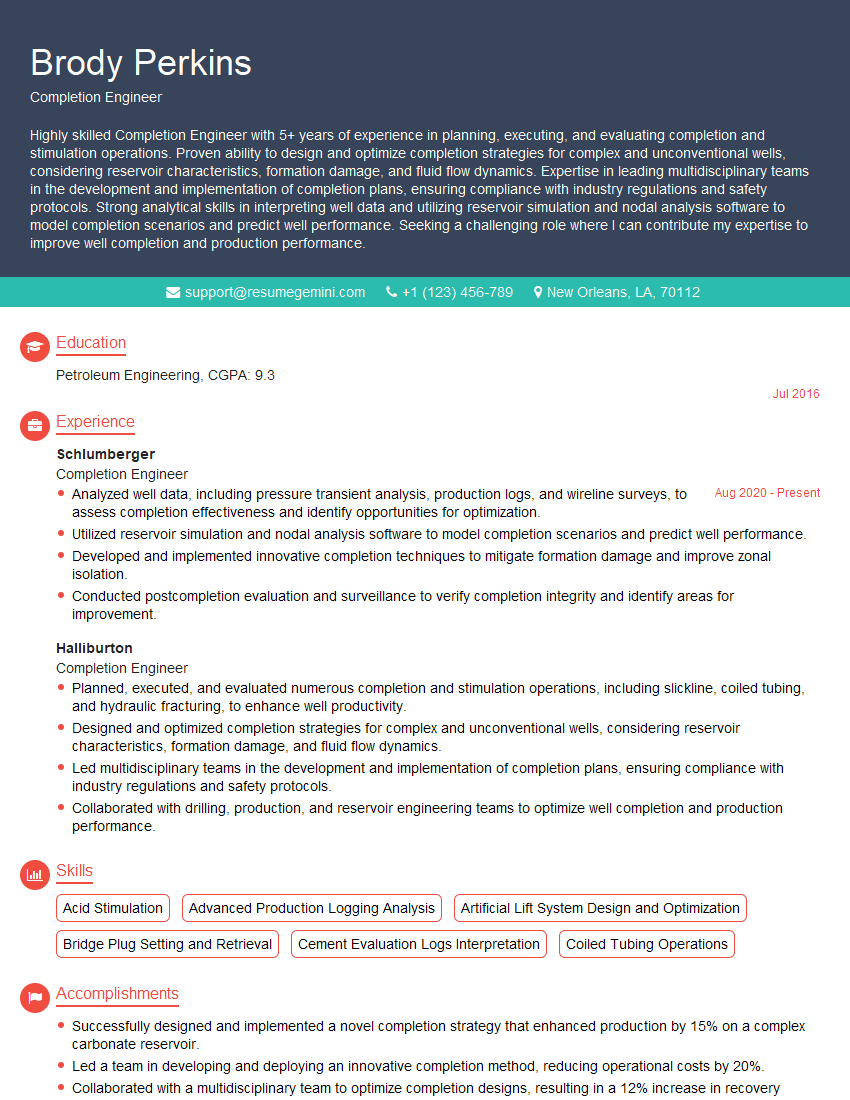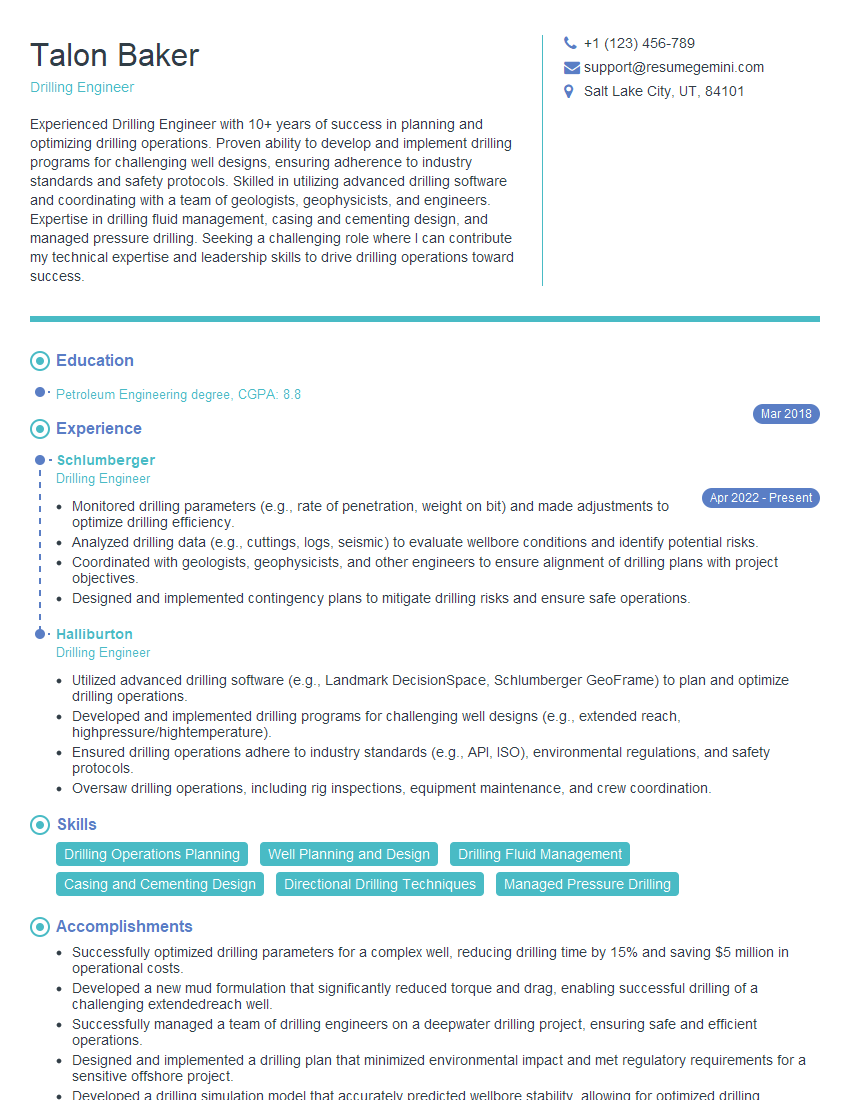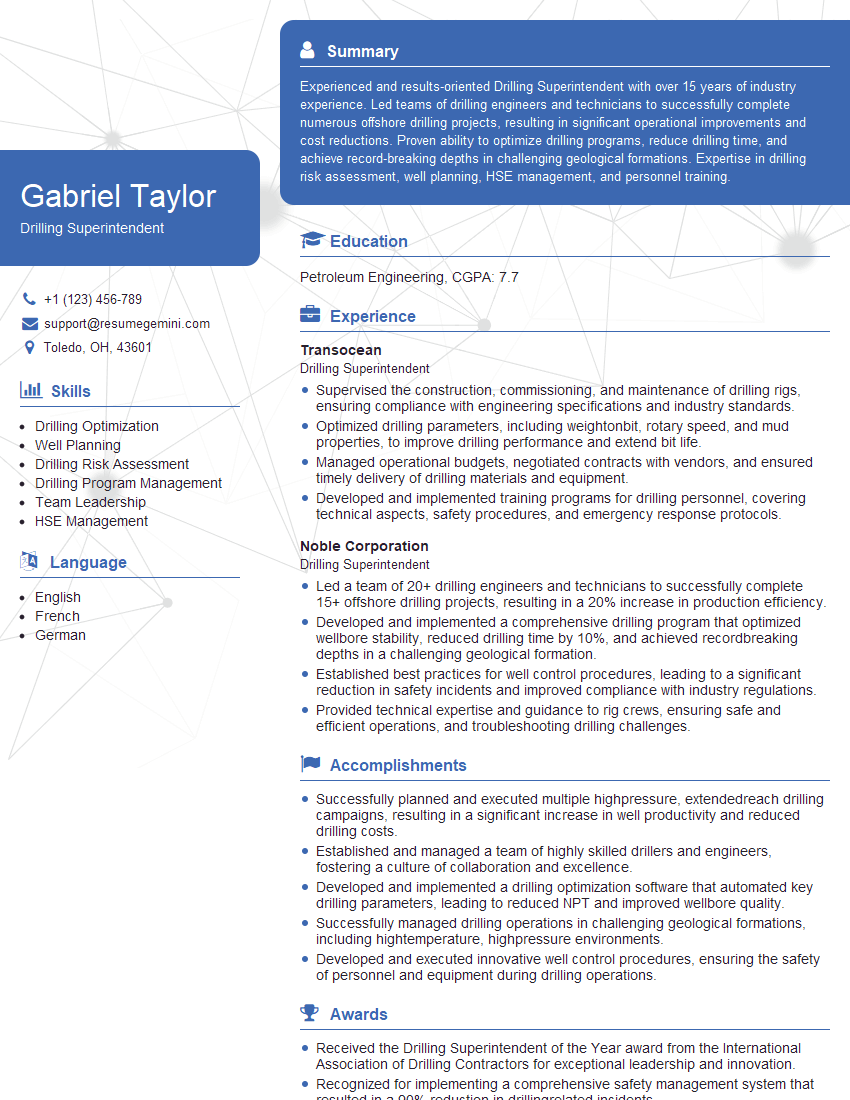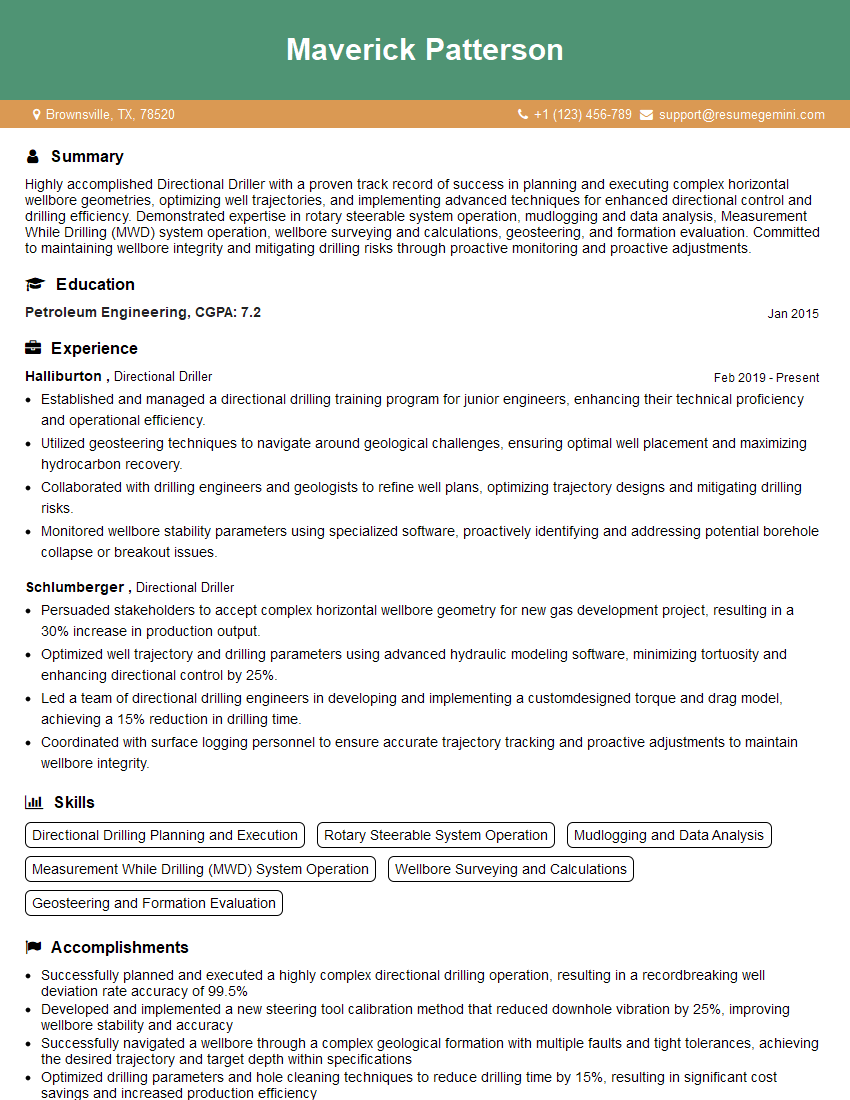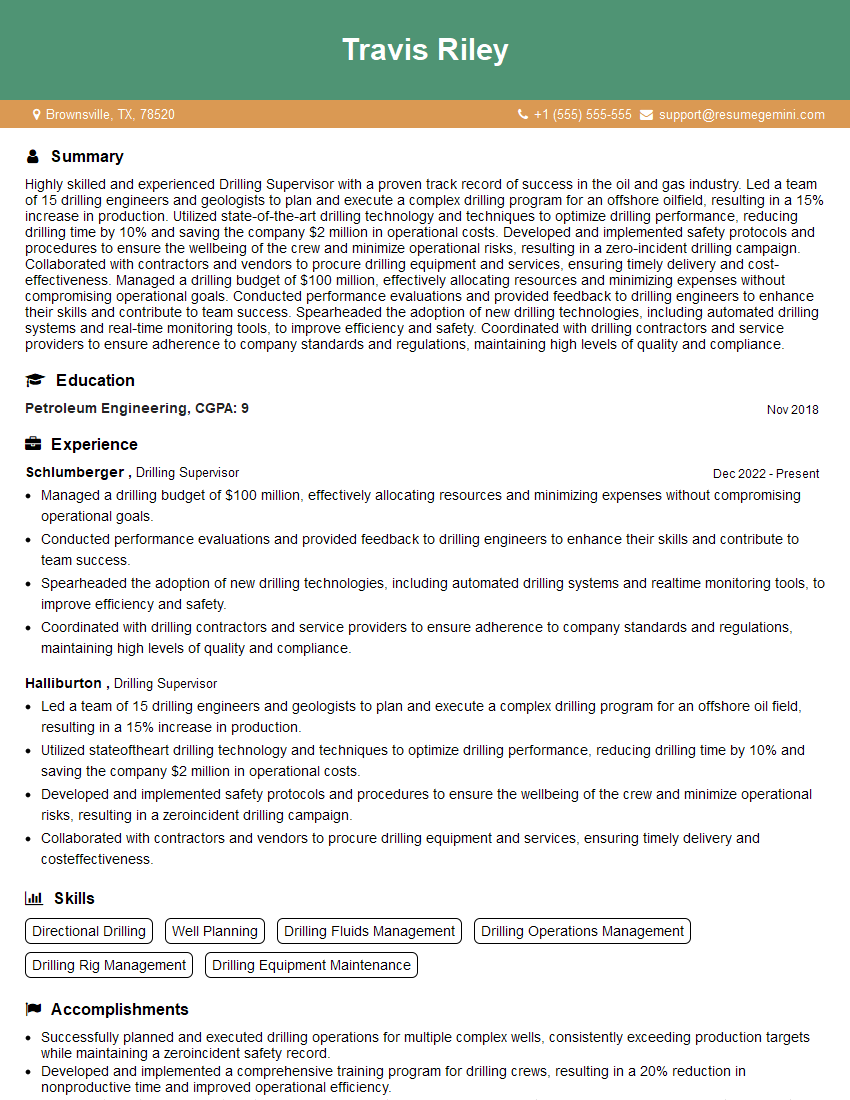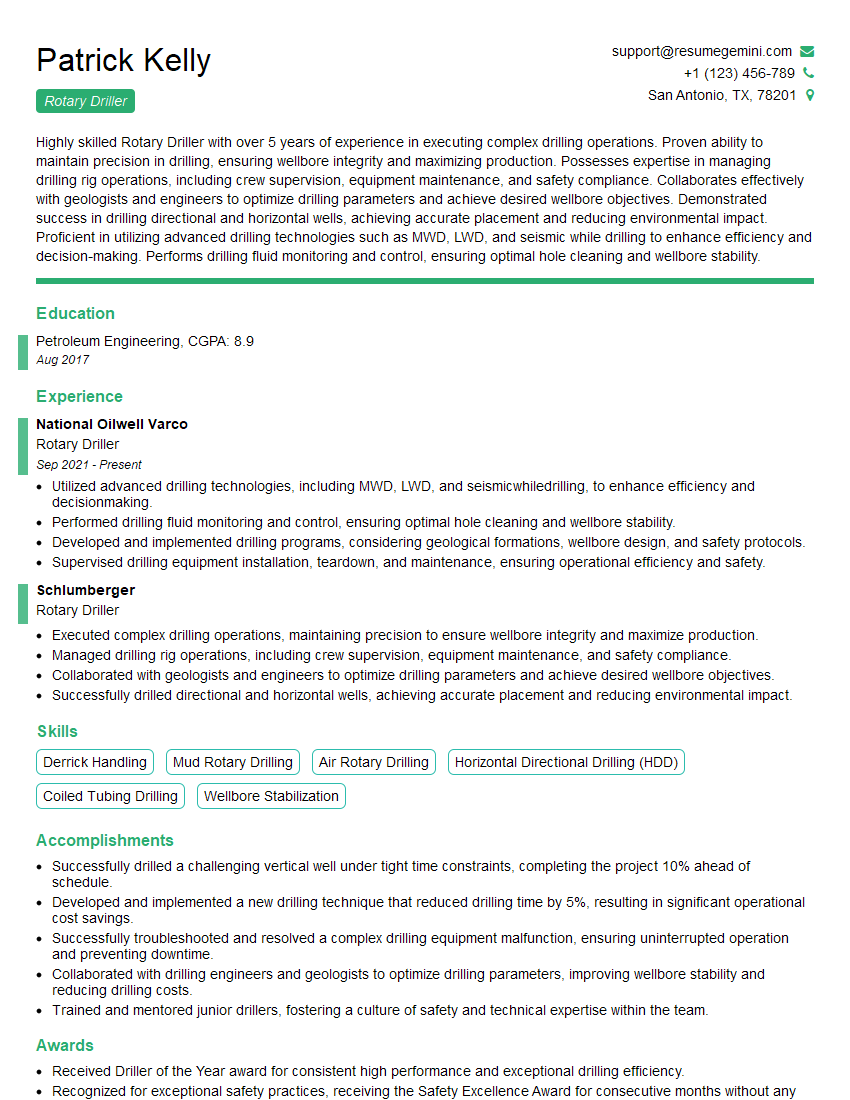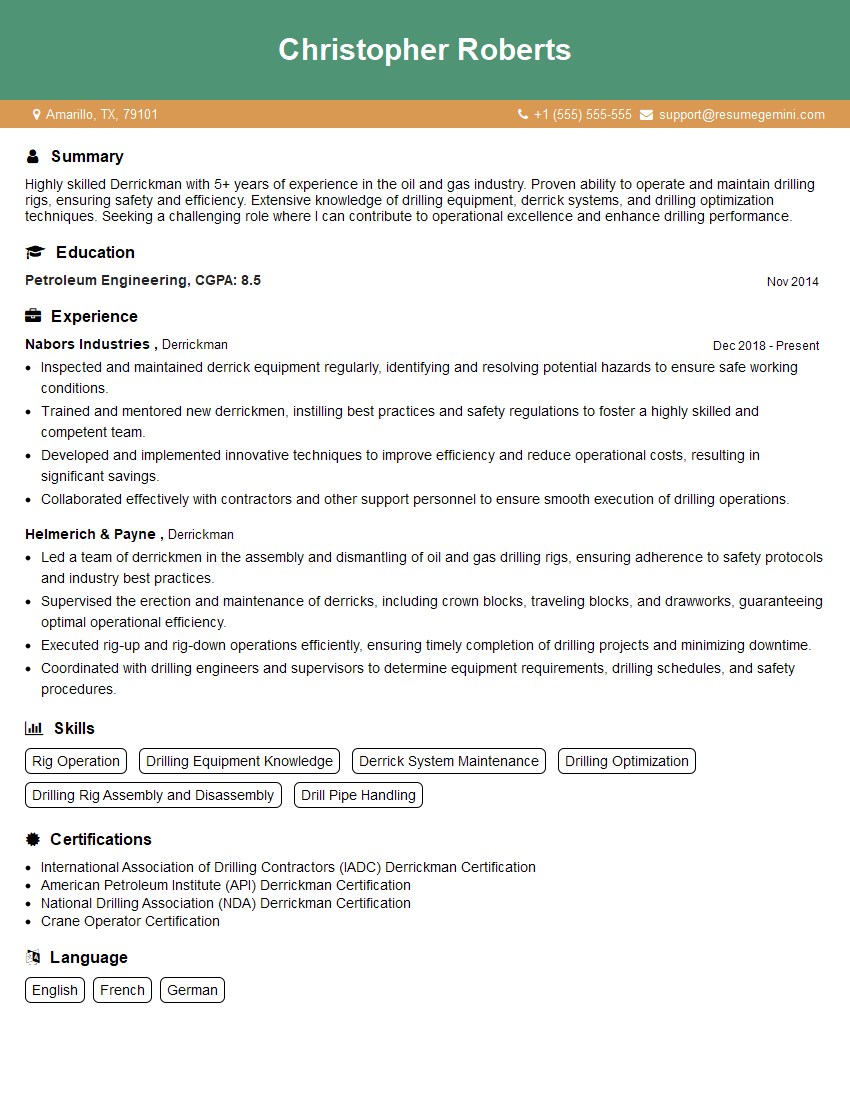Feeling uncertain about what to expect in your upcoming interview? We’ve got you covered! This blog highlights the most important Oil Drilling interview questions and provides actionable advice to help you stand out as the ideal candidate. Let’s pave the way for your success.
Questions Asked in Oil Drilling Interview
Q 1. Explain the different types of drilling rigs.
Drilling rigs are classified based on their mobility and application. There are primarily three main types: land rigs, offshore rigs, and platform rigs.
- Land rigs: These are used on land and vary greatly in size and capacity. Think of them as the workhorses of onshore drilling. From smaller, more mobile rigs used for shallow wells to massive rigs capable of drilling extremely deep wells, they are tailored to the specific project’s needs. For example, a mast-type rig might be used for relatively simpler operations, while a derrick-type rig is essential for deeper, more challenging wells requiring heavier equipment.
- Offshore rigs: These are designed for drilling in water. These include jack-up rigs (legs that raise the rig above the water), semi-submersibles (partially submerged hulls providing stability), and drillships (ships equipped with drilling equipment). The choice depends on water depth and environmental conditions. A jack-up rig is ideal for shallower waters, while a drillship is better suited for deepwater environments.
- Platform rigs: These are fixed structures built on the seabed, typically in shallow to moderate water depths. They offer a more stable platform than mobile offshore rigs and are often used for extended drilling operations. They are more costly to build and install than mobile rigs.
The selection of a rig type depends on factors like well depth, location (onshore or offshore, water depth), geological conditions, and budget. Each rig type has its own advantages and limitations.
Q 2. Describe the process of well planning.
Well planning is a crucial and complex process involving a multidisciplinary team. Its goal is to safely and efficiently drill a well while minimizing risks and maximizing production. It starts with geological studies to identify potential hydrocarbon reservoirs. We then use this data to design the well trajectory – determining the best path to reach the target reservoir. This involves considering factors such as:
- Geological Data: Seismic surveys, well logs from nearby wells, and geological models are analyzed to predict subsurface formations.
- Well Trajectory Design: This defines the path of the wellbore, including its inclination, azimuth, and total depth. Software is used to simulate drilling paths, and this is often tailored to avoid obstructions, optimize reservoir contact, and improve production.
- Drilling Program: A detailed plan for the drilling operation, including time estimations, required equipment, and safety procedures. This part also includes contingency plans.
- Mud Program: Selecting the appropriate drilling mud (discussed in a later question) based on formation characteristics.
- Casing and Cementing Program: This outlines the sizes and placement of the steel casings that will protect the wellbore and isolate various formations.
- Completion Program: A plan for the post-drilling phase, including the installation of production equipment to facilitate oil and gas extraction.
Proper well planning is essential for minimizing risks, such as wellbore instability, unexpected formations, and environmental impacts. A poorly planned well can lead to costly delays and safety issues.
Q 3. What are the key components of drilling mud and their functions?
Drilling mud, also known as drilling fluid, is a crucial element in oil and gas drilling. It’s a carefully engineered fluid pumped down the wellbore to serve multiple critical functions. Key components include:
- Water (or Oil): The base fluid. Oil-based muds are used in certain formations to prevent wellbore instability.
- Clay (Bentonite): Provides viscosity and helps suspend cuttings (rock fragments) and weighting agents.
- Weighting Agents (Barite): Increases the density of the mud to control formation pressure. This helps prevent blowouts.
- Fluid Loss Control Agents (Polymer): Reduce the loss of mud into permeable formations, maintaining wellbore stability.
- Drilling Additives: Various chemicals are added to adjust the mud’s properties. This could include lubricators, corrosion inhibitors, and biocides.
Each component plays a vital role. For example, the weighting agent helps control pressure, preventing the uncontrolled flow of formation fluids (blowouts). The fluid loss control agents prevent mud from leaking into the formation, avoiding pore pressure changes. Improper mud design can result in wellbore instability, stuck pipe, and even blowouts.
Q 4. How do you manage well control incidents?
Well control incidents, such as kicks (influx of formation fluids into the wellbore) or blowouts, are serious situations requiring immediate action. The primary goal is to safely regain control of the well and prevent damage to equipment, personnel, and the environment. A key component is having a well-prepared and trained team.
Management involves a series of steps:
- Immediate Response: Isolate the well by closing valves. Shut down the drilling operation.
- Assessment: Determine the severity of the kick (type and volume of fluids). This involves analyzing the mud weight and flow rates.
- Weight Up the Mud: Increase the density of the drilling mud to overcome formation pressure and prevent further influx.
- Circulation: Circulate the mud to remove the influx fluids from the wellbore. This could involve removing the drilling pipe and circulating the mud from the surface.
- Kill the Well: If circulation doesn’t work, a well kill operation may be necessary using specialized equipment and techniques.
- Post-Incident Analysis: A thorough review of the incident to identify causes, review safety procedures, and implement corrective measures. This helps to prevent future occurrences.
Effective well control relies on proactive measures, regular equipment checks, a well-defined emergency response plan, and comprehensive training for all personnel. One instance I encountered involved a kick during drilling operations where quick and decisive actions using the above process managed to prevent the situation from escalating into a blowout.
Q 5. Explain the principles of directional drilling.
Directional drilling allows us to deviate from a vertical path, enabling access to reservoirs that cannot be reached with vertical wells. It uses specialized tools and techniques to steer the drill bit along a predetermined path.
Key principles:
- Bent Sub: A bent section of drill pipe that creates a directional force on the bit.
- Mud Motors: Hydraulically powered motors that rotate the drill bit, allowing for independent steering and controlled deviation.
- Measurement While Drilling (MWD): Tools on the drill string that measure the wellbore’s inclination and azimuth (direction) and send this data to the surface in real-time.
- Rotary Steerable System (RSS): These advanced systems use sensors and hydraulic actuators to steer the drill bit without rotating the entire drill string. They provide much more precise directional control than conventional mud motors.
Directional drilling is vital for accessing reservoirs in challenging terrain, maximizing reservoir contact, and reducing the environmental footprint by drilling fewer wells. For instance, this technique is crucial in offshore drilling, where multiple wells may branch out from a single platform.
Q 6. What are the safety procedures for working on a drilling rig?
Safety is paramount in oil drilling. Rigorous procedures and training are in place to minimize risks. Key aspects include:
- Personal Protective Equipment (PPE): Mandatory use of helmets, safety glasses, gloves, and other appropriate safety gear.
- Emergency Shutdown Systems: Well-defined procedures and easily accessible emergency shut-down systems (ESD) are vital for rapid response to dangerous situations.
- Permit-to-Work System: A formal system for authorizing work, ensuring that all necessary safety precautions are taken before commencing any task.
- Regular Safety Meetings: Frequent safety meetings and training sessions to reinforce safety procedures and address potential hazards.
- Emergency Response Plan: A detailed plan that outlines procedures for various emergency situations, including fire, spills, and medical emergencies.
- Hazard Identification and Risk Assessment: Regular assessment of potential hazards, and implementation of mitigation measures.
In addition to these, regular equipment inspections and strict adherence to regulations are critical. Safety is not just a procedure, but a culture that must be embedded in every aspect of the drilling operation.
Q 7. Describe your experience with different drilling bit types.
My experience encompasses a wide range of drilling bit types, each suited for specific formation characteristics. The selection of a bit is critical for optimizing drilling rate and bit life.
- Roller Cone Bits: These bits utilize rotating cones with teeth or inserts to crush and break rock. They are robust and effective in hard, abrasive formations, but their performance in softer formations is often less efficient.
- PDC Bits (Polycrystalline Diamond Compact): These bits use synthetic diamonds set in a matrix, offering superior cutting efficiency in a variety of formations. They offer longer life than roller cone bits, making them cost-effective in many scenarios, but they are more susceptible to damage in extremely hard formations.
- Insert Bits: These are roller cone bits with replaceable inserts, extending the bit’s life and minimizing downtime. I’ve used these extensively in formations with variable hardness.
The choice depends on factors like formation hardness, abrasiveness, and the desired rate of penetration. Choosing the wrong bit type can lead to reduced drilling efficiency, increased costs, and even bit failure. For example, using a PDC bit in an extremely hard formation could lead to premature failure, while using a roller cone bit in a soft formation could lead to poor penetration rates.
Q 8. How do you monitor and control drilling parameters (ROP, torque, weight on bit)?
Monitoring and controlling drilling parameters like Rate of Penetration (ROP), torque, and weight on bit (WOB) is crucial for efficient and safe drilling. It’s like driving a car – you need to monitor your speed (ROP), steering (torque), and how hard you’re pressing on the accelerator (WOB) to reach your destination safely and efficiently.
We use sophisticated downhole drilling sensors and surface monitoring systems. These sensors measure parameters in real-time and transmit data to the surface via the drilling mud. The data is then displayed on a drilling control panel, allowing the drilling team to observe trends and make adjustments. For instance, if ROP is low, we might increase WOB or change the drilling bit. If torque is excessively high, we might reduce WOB or investigate potential downhole issues like a stuck pipe. The parameters are constantly monitored and adjusted to maintain optimal drilling efficiency while avoiding potentially damaging situations.
- ROP (Rate of Penetration): Indicates the speed at which the drill bit is penetrating the formation. Low ROP could signify a hard formation or dull bit, while excessively high ROP might indicate the risk of wellbore instability.
- Torque: Measures the rotational force on the drillstring. High torque can indicate problems such as a stuck pipe, hole cleaning issues, or problems with the bit.
- WOB (Weight on Bit): Represents the weight applied to the drill bit, influencing penetration rate. Too little WOB might result in slow penetration, whereas too much WOB can lead to bit damage or stuck pipe.
These parameters are managed through a dynamic process involving real-time data analysis, engineering calculations, and informed decisions by the drilling team. We often use automated systems and sophisticated software to optimize these parameters based on geological data and drilling conditions.
Q 9. Explain the concept of hydraulic fracturing (fracking).
Hydraulic fracturing, or fracking, is a well stimulation technique used to increase the permeability of low-permeability formations, allowing for easier flow of hydrocarbons. Imagine trying to drink from a sponge – the liquid doesn’t flow easily. Fracking is like creating cracks in the sponge to make the liquid flow more freely.
The process involves pumping a high-pressure mixture of water, sand (proppant), and chemicals into a wellbore after the initial drilling and casing. This high-pressure fluid creates fractures in the surrounding rock formation. The sand particles prop the fractures open, creating pathways for oil and gas to flow more easily to the wellbore. The chemicals aid in the fracturing process and help control the properties of the fracturing fluid.
Fracking is vital for extracting hydrocarbons from shale and tight formations, which were previously uneconomical to produce. However, it is crucial to carefully manage the process, employing environmental safeguards and minimizing potential risks to groundwater and the environment. The selection of appropriate proppants and fracturing fluid design is crucial to optimize production while maintaining well integrity and respecting environmental regulations.
Q 10. How do you identify and mitigate risks associated with drilling operations?
Risk mitigation in drilling is paramount. We approach it using a multi-layered system that involves proactive planning, rigorous execution, and continuous monitoring. Think of it as a layered defense against potential problems.
- Hazard Identification and Assessment: Before drilling starts, we conduct a thorough hazard identification and risk assessment, considering geological conditions, equipment reliability, and human factors. This involves detailed well planning, geomechanical modeling, and risk matrix development.
- Well Planning and Design: A detailed well plan outlines the drilling process, including casing programs, mud weights, and drilling parameters. The plan incorporates contingency plans to handle potential challenges.
- Emergency Response Planning: We develop comprehensive emergency response plans, including procedures for handling well control incidents, equipment failure, and environmental emergencies. Regular drills and training sessions ensure preparedness.
- Real-time Monitoring and Control: Continuous monitoring of drilling parameters, pressure data, and equipment performance is vital for detecting potential problems early. This involves sophisticated sensors, data analysis software, and experienced personnel.
- Communication and Teamwork: Effective communication and teamwork amongst the drilling team, engineering support, and management are crucial for mitigating risks and ensuring a safe operation.
Examples of specific risk mitigation strategies include using advanced drilling fluids to prevent wellbore instability, employing blowout preventers (BOPs) to control well pressure, and implementing stringent safety protocols to minimize human error. Each risk is analyzed and appropriate mitigation strategies are implemented based on a structured risk assessment and mitigation plan.
Q 11. What is the role of a mud logger in drilling operations?
The mud logger plays a critical role in the drilling process, acting as the eyes and ears of the subsurface. They’re essentially the geologists on the drilling rig, constantly monitoring the drilling mud for indicators of subsurface formations.
Their primary responsibility is analyzing the cuttings (rock fragments) brought up by the drilling mud. They identify formations, assess lithology (rock type), and check for indications of hydrocarbons like gas or oil. The mud logger maintains detailed records, including descriptions of cuttings, gas readings, and other relevant information. This information is crucial for formation evaluation, geological modeling, and real-time decision-making during drilling.
Moreover, they monitor the drilling mud properties, searching for anomalies that might indicate changes in formation pressure or the presence of hydrocarbons. They maintain a detailed log of the drilling progress, providing valuable data for geologists, engineers, and other stakeholders. The mud logger acts as a critical link between subsurface information and the surface drilling operations, contributing significantly to the overall safety and efficiency of the operation.
Q 12. Describe your experience with different types of cementing operations.
Cementing operations are crucial for ensuring wellbore integrity and preventing fluid leaks or migration. I’ve been involved in various cementing operations, including:
- Primary Cementing: This is the initial cement job, where cement is placed behind the casing to seal off the annulus (the space between the wellbore and the casing). This is crucial for pressure control and preventing wellbore collapse. We use various techniques like displacement calculations and cement slurry design to ensure complete and proper placement. I’ve worked with different cement types, optimizing the design based on formation properties and wellbore conditions.
- Secondary Cementing: This involves remedial cementing to fix issues like channel leaks or poor primary cement placement. It may require specialized techniques like squeeze cementing or plug & perf cementing, depending on the specific problem. I’ve had experience troubleshooting these issues, analyzing well logs and pressure tests to identify the root cause and design the most effective remedial cementing strategy.
- Plug & Abandonment Cementing: This involves permanently sealing the well, usually at the end of its life. This involves multiple stages of cementing and potentially the use of special cement materials to guarantee a permanent and secure seal, preventing environmental contamination. I’ve been directly involved in the planning and execution of this complex process, adhering to strict regulatory requirements.
In all cementing operations, careful planning and quality control are crucial. This includes cement slurry design, accurate placement calculations, and post-cementing evaluation using various logging techniques to confirm proper cement placement and zonal isolation.
Q 13. Explain your understanding of formation evaluation during drilling.
Formation evaluation during drilling involves gathering and interpreting data about the geological formations encountered during drilling. It’s like taking a geological ‘fingerprint’ of the formations we’re drilling through. This information is essential for reservoir characterization, optimizing hydrocarbon production, and making crucial decisions during the drilling process.
Various methods are used, including:
- Cuttings Analysis: Examining rock fragments from the mud provides information on lithology, porosity, and potential hydrocarbon indicators. I’ve been involved in numerous projects analyzing cuttings to identify key formations and stratigraphic markers.
- Mud Logging: Monitoring drilling mud properties and gas analysis yields real-time data on subsurface pressure and potential hydrocarbon zones. I have extensive experience interpreting mud log data to identify potential pay zones and drilling hazards.
- Wireline Logging (while drilling or after): After drilling, wireline logging tools are used to measure various physical properties of the formations, such as porosity, permeability, and hydrocarbon saturation. I am proficient in interpreting wireline log data to generate accurate geological models and estimate reservoir potential.
The data obtained from these methods helps us understand the subsurface geology, identify potential hydrocarbon reservoirs, assess reservoir quality, and plan completion strategies to optimize production. Effective formation evaluation is crucial for efficient and economical drilling operations.
Q 14. How do you interpret drilling data and identify potential problems?
Interpreting drilling data and identifying potential problems requires a combination of experience, technical knowledge, and a systematic approach. Think of it as detective work, but for the subsurface. We utilize various data sources and techniques to identify and troubleshoot issues. The following illustrates a standard workflow:
- Data Gathering: We gather data from various sources, including drilling parameters (ROP, torque, WOB), mud logging data, pressure readings, and wireline logs.
- Data Analysis: We analyze the data using specialized software and our technical expertise, looking for trends, anomalies, and deviations from the planned drilling parameters.
- Pattern Recognition: Experienced drillers can recognize patterns in data that indicate potential problems. For instance, a sudden increase in torque might suggest a stuck pipe, while a decrease in ROP could indicate a hard formation or a dull bit. My experience allows me to quickly identify these critical indicators.
- Problem Diagnosis: Once a potential problem is identified, we investigate its cause, considering various factors such as geological conditions, drilling parameters, and equipment malfunction.
- Mitigation Strategy: Based on the diagnosis, we develop a mitigation strategy. This could involve adjusting drilling parameters, changing the drilling bit, implementing well control procedures, or making other necessary interventions.
An example: If we observe a sharp increase in torque and a simultaneous decrease in ROP, coupled with increased mud returns, it suggests a potential stuck pipe. We would then investigate further, possibly using specialized logging tools to assess the situation and implement procedures for freeing the pipe before escalating the problem.
Q 15. What is your experience with well logging tools and interpretation?
Well logging is crucial for understanding subsurface formations. My experience encompasses a wide range of logging tools, from basic wireline logs like gamma ray, resistivity, and porosity logs to more advanced tools such as nuclear magnetic resonance (NMR) and formation micro-imager (FMI) logs. I’m proficient in interpreting these logs to determine reservoir properties like porosity, permeability, water saturation, and lithology. For example, I once used a combination of gamma ray and neutron porosity logs to identify a thin, high-porosity sandstone reservoir that wasn’t initially apparent from seismic data. This led to a significant increase in production estimates for that well. My interpretation process involves not only analyzing individual logs but also integrating them with other data, like core samples and pressure tests, to build a comprehensive reservoir model.
I’m also familiar with advanced logging techniques, such as logging while drilling (LWD) and measurement while drilling (MWD), which provide real-time data during the drilling process. This allows for quicker decision-making regarding drilling parameters and formation evaluation. This real-time information is critical for optimizing drilling efficiency and reducing non-productive time (NPT).
Career Expert Tips:
- Ace those interviews! Prepare effectively by reviewing the Top 50 Most Common Interview Questions on ResumeGemini.
- Navigate your job search with confidence! Explore a wide range of Career Tips on ResumeGemini. Learn about common challenges and recommendations to overcome them.
- Craft the perfect resume! Master the Art of Resume Writing with ResumeGemini’s guide. Showcase your unique qualifications and achievements effectively.
- Don’t miss out on holiday savings! Build your dream resume with ResumeGemini’s ATS optimized templates.
Q 16. Describe your experience with different types of drilling fluids.
My experience with drilling fluids spans various types, each with its unique properties and applications. Water-based muds (WBM) are common for their environmental friendliness and cost-effectiveness, but their performance can be limited in certain formations. Oil-based muds (OBM) are used where shale instability is a concern, as they provide better shale inhibition. Synthetic-based muds (SBM) offer a compromise between the performance of OBM and the environmental benefits of WBM. The choice of mud type depends on many factors, including the formation’s lithology, pressure, and temperature.
I have experience formulating and managing these different mud systems. This includes optimizing rheological properties (viscosity, yield point, gel strength), managing solids content, and maintaining the correct density to prevent wellbore instability. In one project, we switched from a WBM to an SBM to mitigate wellbore instability issues in a challenging shale formation. This significantly reduced the instances of stuck pipe and improved the overall drilling efficiency.
Q 17. How do you ensure the environmental compliance of drilling operations?
Environmental compliance is paramount in oil drilling operations. My approach involves a multi-faceted strategy that begins with pre-planning. This includes conducting thorough environmental impact assessments, obtaining the necessary permits, and developing a comprehensive environmental management plan. During operations, we meticulously monitor and control the discharge of drilling fluids and cuttings, ensuring adherence to all regulatory standards. Regular water quality testing is essential to detect and address any potential pollution.
We also implement best practices such as using environmentally friendly drilling fluids, minimizing waste generation through effective recycling and waste management programs, and using closed-loop systems to reduce the discharge of drilling fluids. For example, I’ve been involved in projects where we used specialized equipment to separate and recycle drilling fluids, significantly reducing the volume of waste requiring disposal. Furthermore, we conduct regular training for all personnel on environmental regulations and best practices to ensure a culture of environmental responsibility.
Q 18. What are your strategies for optimizing drilling efficiency?
Optimizing drilling efficiency involves a holistic approach targeting all aspects of the operation. One key strategy is proactive well planning, which includes detailed geological modeling, optimizing drilling parameters (weight on bit, rotary speed, flow rate), and selecting the right drilling tools. Real-time data analysis from LWD/MWD tools allows for dynamic adjustments during drilling, minimizing NPT caused by unexpected geological challenges. Effective communication and coordination between different teams is crucial to prevent delays.
Another strategy involves adopting advanced drilling techniques like managed pressure drilling (MPD), which helps maintain wellbore stability and prevent kicks, thereby reducing non-productive time. Regular equipment maintenance and preventive measures also play a crucial role in maximizing uptime. In one project, by implementing a combination of these strategies, we reduced the overall drilling time by 15%, resulting in significant cost savings.
Q 19. How do you handle communication and coordination with different teams on a drilling rig?
Effective communication is the backbone of any successful drilling operation. On a drilling rig, communication involves several teams, including drilling engineers, mud engineers, geologists, directional drillers, and rig crew. I utilize a variety of communication methods, including daily meetings, regular updates via email and instant messaging, and direct, concise communication during critical events. Clear and consistent communication is essential to ensure everyone is informed and working towards common goals.
Establishing clear roles and responsibilities and fostering a collaborative environment are also key. I always emphasize the importance of open communication, active listening, and a culture of mutual respect. For example, I once resolved a potential safety issue quickly and effectively by promptly communicating an unexpected formation change to the drilling crew and making immediate adjustments to the drilling plan.
Q 20. Explain your experience with troubleshooting drilling equipment malfunctions.
Troubleshooting equipment malfunctions requires a systematic approach. I begin by carefully assessing the situation, gathering data from various sources (logs, alarms, crew reports), and identifying the symptoms. Then, I use my knowledge of the equipment and drilling processes to formulate potential causes and prioritize them based on likelihood and impact. This often involves reviewing operational logs, checking pressure gauges, and inspecting the equipment physically.
Once a potential cause has been identified, I implement a series of diagnostic steps to confirm the diagnosis and develop a solution. This may involve replacing faulty components, making adjustments to drilling parameters, or consulting with equipment manufacturers. Documentation of the problem, solution, and preventive measures is crucial to prevent future occurrences. For instance, I once successfully diagnosed and resolved a stuck pipe incident by carefully analyzing the downhole pressure data and implementing a controlled back-reaming procedure.
Q 21. Describe your experience with different types of drilling bits and their applications.
Drilling bits are essential tools that determine drilling efficiency and cost. My experience encompasses various types of bits, including roller cone bits (for harder formations), PDC (polycrystalline diamond compact) bits (for softer formations), and diamond bits (for extremely hard formations). The selection of the appropriate bit depends on factors such as formation hardness, abrasiveness, and the desired rate of penetration (ROP).
For example, in a hard, abrasive formation, a roller cone bit with carbide inserts would be preferable to a PDC bit. Conversely, in a softer, less abrasive formation, a PDC bit may be more efficient. Understanding the strengths and limitations of each bit type allows for the optimization of drilling performance. I regularly evaluate bit performance data, such as ROP, torque, and weight on bit, to identify areas for improvement and select the most effective bits for each drilling stage.
Q 22. How do you manage drilling costs effectively?
Effective drilling cost management requires a multi-faceted approach, focusing on pre-drilling planning, real-time monitoring, and post-drilling analysis. It’s like building a house – you wouldn’t start without blueprints and a budget!
- Pre-Drilling Planning: This involves detailed geological studies, well design optimization (choosing the right trajectory and drilling parameters), and meticulous procurement of equipment and services. We use advanced software to model different scenarios and select the most cost-effective approach. For example, we might choose a longer reach well to access multiple reservoirs, reducing the number of individual wells needed.
- Real-time Monitoring and Control: During drilling, we constantly monitor drilling parameters like rate of penetration (ROP), torque, and drag. Any anomalies are immediately investigated to prevent costly delays or equipment damage. We utilize sophisticated data analytics to identify areas for improvement in real-time. For instance, if ROP drops unexpectedly, we adjust the mud weight or drilling parameters to optimize performance.
- Post-Drilling Analysis: After the well is completed, we conduct a thorough review of all operational data to identify areas of cost overruns and inefficiencies. This analysis helps in improving future drilling operations. We might find that a specific type of drill bit consistently outperforms others, allowing us to standardize and save costs.
Ultimately, effective cost management is about proactive planning, efficient execution, and continuous improvement, aiming for the highest efficiency with the lowest expenditure.
Q 23. What are the common causes of stuck pipe and how do you address them?
Stuck pipe is a dreaded event in drilling, halting operations and leading to significant costs. Think of it like a car getting stuck in mud – you need to carefully assess the situation and apply the right technique to get it moving again.
- Causes: Common causes include differential sticking (where the drillstring is stuck against the formation due to pressure differences), key seating (where the drillstring becomes wedged in a narrow section of the wellbore), and mechanical problems (like a broken drillstring component).
- Addressing Stuck Pipe: Our approach is systematic. First, we carefully analyze the situation using logging tools to determine the cause and location of the problem. Then, we try conservative measures like circulating the drilling mud to wash away cuttings or applying weight to the drillstring. If these fail, more aggressive techniques may be employed, such as using specialized tools like jar and reciprocating tools to free the pipe. In extreme cases, we may need to cut the stuck pipe and fish out the remaining section using specialized fishing tools. The key is to minimize damage to the wellbore and the equipment while working to efficiently recover the stuck pipe.
Prevention is better than cure; good well planning and careful drilling practices significantly reduce the risk of stuck pipe.
Q 24. Describe your experience with different types of completion techniques.
Completion techniques are crucial for producing hydrocarbons from a well. They’re the finishing touches that ensure efficient and safe production. I’ve worked with various types, each tailored to specific reservoir characteristics.
- Conventional Completion: This involves setting casing, perforating the casing to create access points to the reservoir, and installing production tubing and packers to control fluid flow. This is the most common approach for simpler reservoirs.
- Multi-lateral Completions: These involve drilling multiple branches from a single wellbore, allowing access to a wider area within the reservoir. This is particularly useful in fractured or heterogeneous reservoirs. I worked on a project where a multi-lateral well increased production by 30% compared to a similar conventional well.
- Hydraulic Fracturing (Fracking): This technique involves injecting high-pressure fluids into the formation to create fractures, enhancing permeability and increasing production from tight reservoirs. I’ve been involved in designing and overseeing multiple fracking operations, carefully choosing the right proppants and fluid types to optimize the fracture network.
- Underbalanced Drilling: This involves maintaining lower pressure in the wellbore than the reservoir pressure, minimizing formation damage and increasing production. It requires careful control of pressure and flow rates, which I’ve mastered through years of experience.
The choice of completion technique is always site-specific, requiring a thorough understanding of reservoir properties and production goals. Each technique presents unique challenges and necessitates rigorous planning and execution.
Q 25. Explain your understanding of wellbore stability.
Wellbore stability is paramount to safe and efficient drilling. It refers to the ability of the wellbore to remain intact and prevent problems like wellbore collapse or swelling of formations. Imagine building a tunnel – you need to ensure the walls are strong enough to support themselves.
Several factors influence wellbore stability, including:
- Formation Properties: The strength and stress state of the surrounding rock formations play a crucial role. Some formations are naturally unstable and prone to collapse, while others are very strong. We use geological modeling to assess this.
- Mud Properties: The drilling mud’s density, viscosity, and chemical properties are carefully managed to control pore pressure and prevent instability. Choosing the right mud is vital – too light, and the formation may collapse; too heavy, and it may fracture.
- Drilling Parameters: The rate of penetration, torque, and weight on the bit affect the wellbore’s integrity. Aggressive drilling can induce fractures and lead to instability.
Maintaining wellbore stability involves carefully controlling mud properties, optimizing drilling parameters, and using advanced logging tools to monitor the wellbore’s condition. Real-time monitoring and adjustment of parameters are key to ensuring the wellbore remains stable throughout the drilling process.
Q 26. How do you maintain accurate drilling records and reports?
Maintaining accurate drilling records and reports is critical for optimizing operations, ensuring safety, and complying with regulations. It’s like keeping a meticulous diary of a complex project – detail and accuracy are paramount.
- Real-time Data Acquisition: We use advanced drilling automation systems to capture real-time data from various sensors. This includes parameters like drilling parameters, mud properties, and wellbore conditions.
- Data Management System: We use specialized software to store, organize, and analyze the data. This system ensures data integrity and provides easy access to all relevant information.
- Regular Reporting: We generate standardized reports summarizing key parameters, drilling performance, and any unusual events. These reports are shared with the relevant stakeholders (clients, safety personnel).
- Data Validation: Regular data validation procedures are in place to ensure accuracy and consistency. We cross-reference data from different sources and employ quality control checks.
Accurate record-keeping allows us to analyze past performance, identify trends, optimize future operations, and provide irrefutable evidence in case of incidents or disputes.
Q 27. What are the key performance indicators (KPIs) for a successful drilling operation?
Key performance indicators (KPIs) for a successful drilling operation are multi-faceted and focus on safety, efficiency, and cost-effectiveness. They’re like the vital signs of a patient – constantly monitored for optimal health.
- Safety: Days without lost-time incidents (DLTIs) is paramount. Every operation is designed with safety as the primary concern.
- Drilling Efficiency: Rate of penetration (ROP), trip time, and non-productive time (NPT) are key metrics for measuring efficiency. Higher ROP and lower NPT indicate efficient drilling.
- Cost-Effectiveness: Cost per foot drilled, total well cost, and cost per barrel of oil equivalent (BOE) are critical. We strive to minimize costs while maximizing production.
- Wellbore Stability: Number of stuck pipe incidents, wellbore instability events, and mud loss volumes are indicators of wellbore stability. Minimizing these indicates successful management of wellbore stability.
- Environmental Impact: Waste generated, water usage, and emissions are increasingly important KPIs, reflecting our commitment to environmental stewardship.
Tracking these KPIs allows us to monitor progress, identify areas for improvement, and ultimately ensure the success of a drilling operation. Regular monitoring and analysis of these KPIs are crucial for continuous improvement.
Key Topics to Learn for Your Oil Drilling Interview
- Drilling Fluids: Understand the properties and functions of different drilling muds, their impact on wellbore stability, and how to optimize their performance for various geological formations. Consider practical applications like managing rheological properties and optimizing drilling parameters to prevent wellbore instability.
- Well Control: Master the principles of well control, including kick detection, prevention, and control techniques. Explore practical scenarios involving pressure management, using safety equipment, and responding to potential emergencies. Further delve into the different types of well control equipment and their applications.
- Drilling Equipment and Operations: Familiarize yourself with the various components of a drilling rig, their functions, and the operational procedures involved in drilling a well. Focus on practical applications like understanding the role of the top drive, mud pumps, and the drilling process itself. Consider exploring troubleshooting common drilling equipment malfunctions.
- Formation Evaluation: Learn about the methods used to evaluate the properties of subsurface formations, including wireline logging techniques and their interpretations. Practical applications include understanding the data gathered from these logs to assess reservoir quality and potential hydrocarbon reserves. Explore different log types and their applications in various geological settings.
- Health, Safety, and Environment (HSE): Demonstrate a strong understanding of HSE regulations and best practices in the oil and gas industry. This includes understanding risk assessment, emergency response procedures, and environmental protection measures. Explore practical scenarios involving incident prevention and response.
- Reservoir Engineering Fundamentals: Develop a basic understanding of reservoir properties, fluid flow in porous media, and pressure considerations. This will enhance your ability to discuss the interaction between drilling operations and the reservoir itself. Consider exploring basic reservoir simulation concepts.
Next Steps
Mastering the key concepts of oil drilling is crucial for a successful and rewarding career in this dynamic industry. It opens doors to various specialized roles and provides opportunities for continuous professional growth and development. To significantly improve your job prospects, focus on crafting a compelling and ATS-friendly resume that highlights your skills and experience effectively. We recommend using ResumeGemini, a trusted resource that can help you build a professional resume optimized for applicant tracking systems. ResumeGemini provides examples of resumes tailored to the oil drilling industry to help you get started. Make your resume stand out and showcase your potential!
Explore more articles
Users Rating of Our Blogs
Share Your Experience
We value your feedback! Please rate our content and share your thoughts (optional).
What Readers Say About Our Blog
Hi, I’m Jay, we have a few potential clients that are interested in your services, thought you might be a good fit. I’d love to talk about the details, when do you have time to talk?
Best,
Jay
Founder | CEO
